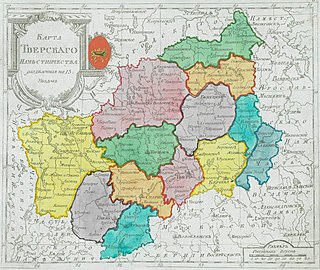Related Research Articles
Nyland and Tavastehus County was a county of the Swedish Empire in Finland from 1634 to 1809.

Kursk Oblast is a federal subject of Russia. Its administrative center is the city of Kursk. As of the 2021 census, Kursk Oblast had a population of 1,082,458.
A governorate was a major and principal administrative subdivision of the Russian Empire. After the Bolshevik Revolution in 1917, governorates remained as subdivisions in the Byelorussian, Russian and Ukrainian Soviet republics, and in the Soviet Union from its formation in 1922 until 1929. The term is also translated as government or province. A governorate was headed by a governor, a word borrowed from Latin gubernator, in turn from Greek kyvernítis.

The Baltic Governorates, originally the Ostsee Governorates, was a collective name for the administrative units of the Russian Empire set up in the territories of Swedish Estonia, Swedish Livonia (1721) and, afterwards, of the Duchy of Courland and Semigallia (1795).

Kuskovo was the summer country house and estate of the Sheremetev family. Built in the mid-18th century, it was originally situated several miles to the east of Moscow but now is part of the East District of the city. It was one of the first great summer country estates of the Russian nobility, and one of the few near Moscow still preserved. Today the estate is the home of the Russian State Museum of Ceramics, and the park is a favourite place of recreation for Muscovites.

The modern administrative-territorial structure of Russia is a system of territorial organization which is a product of a centuries-long evolution and reforms.

Kazan Governorate was an administrative-territorial unit (guberniya) of the Tsardom of Russia, the Russian Empire, and the Russian SFSR from 1708 to 1920, with its capital in Kazan.

Smolensk Governorate was an administrative-territorial unit (guberniya) of the Tsardom of Russia, the Russian Empire, and the Russian SFSR. It existed, with interruptions, between 1708 and 1929.
Administratively, Tver Oblast is divided into two urban-type settlements under the federal government management, five cities and towns of oblast significance, and thirty-six districts.
Reval Governorate was an administrative-territorial unit (guberniya) and one of the Baltic governorates of the Russian Empire, which existed from 1719 to 1783. Its capital was in Reval (Tallinn).
The Kazan Province was a province of Kazan Governorate of the Russian Empire, which existed 1719–1775. Its center was the city of Kazan.

In the Imperial Russian Army, a military district was a territorial association of military units, formations, military schools, and various local military establishments. This territorial division type was utilized to provide a more efficient management of army units, their training and other operations activities related to combat readiness.

Vilna Military District was a military district of the Imperial Russian Army. The district was formed in 1862 as part of Russian military reforms and was responsible for parts of modern Belarus, Latvia, Lithuania, and Poland. The district was disbanded at the beginning of the First World War in July 1914, and its headquarters were used to form another district farther to the rear.

Siberia Governorate was an administrative-territorial unit (guberniya) of the Tsardom of Russia and the Russian Empire, which existed from 1708 until 1782. Its seat was in Tobolsk. The governorate was located in the east of Russian Empire and bordered China in the south, Kazan Governorate in the southwest, and Archangelgorod Governorate in the northwest. In the north and the east, the governorate was limited by the seas of the Arctic and Pacific Oceans. In terms of area, Siberia Governorate was by far the biggest of all the governorates, as it included areas in the Urals, Siberia, and the Russian Far East some of which were not yet even settled by Russians at the time.

Voronezh Governorate was an administrative-territorial unit (guberniya) of the Tsardom of Russia, the Russian Empire, and the Russian SFSR, which existed from 1708 to 1779 and again from 1796 to 1928. Its capital was located in Voronezh since 1725.

Kiev Governorate was an administrative-territorial unit (guberniya) of the Tsardom of Russia and the Russian Empire. It was established in December 1708 as one of the eight guberniyas first created during the reforms of Peter the Great.

Tver Viceroyalty was an administrative-territorial unit (namestnichestvo) of the Russian Empire, which existed from 1775 until 1796. Its seat was in Tver. In 1796, it was transformed to Tver Governorate.

Novotorzhsky Uyezd was an administrative-territorial unit (uyezd) of the Tver Governorate as part of the Russian Empire and the Russian Soviet Federative Socialist Republic. The uyezd town was Torzhok.
References
- ↑ http://geo.1september.ru/view_article.php?ID=200101502 Изменение административно-территориального деления России за последние 300 лет